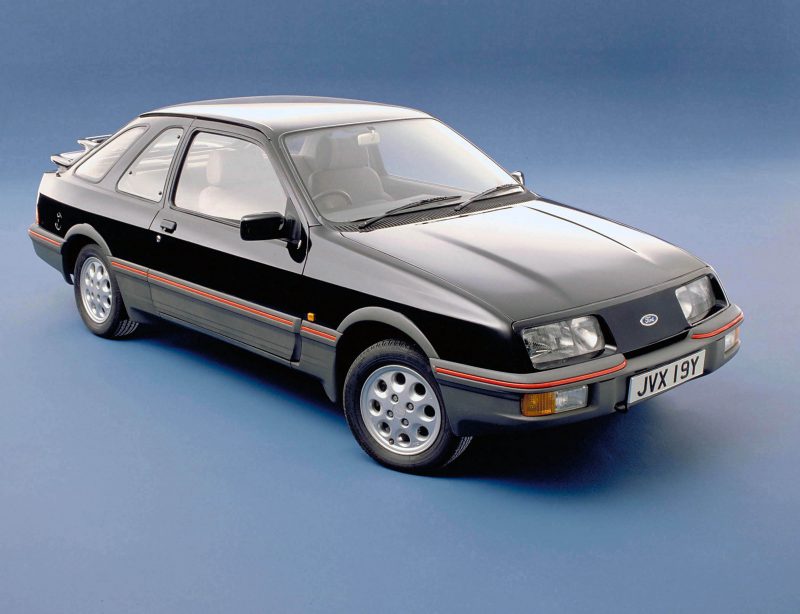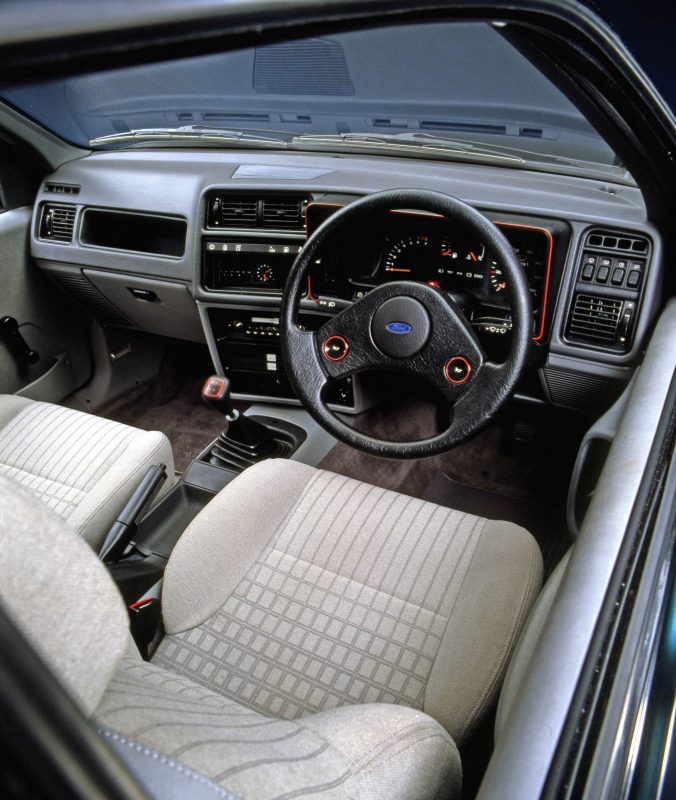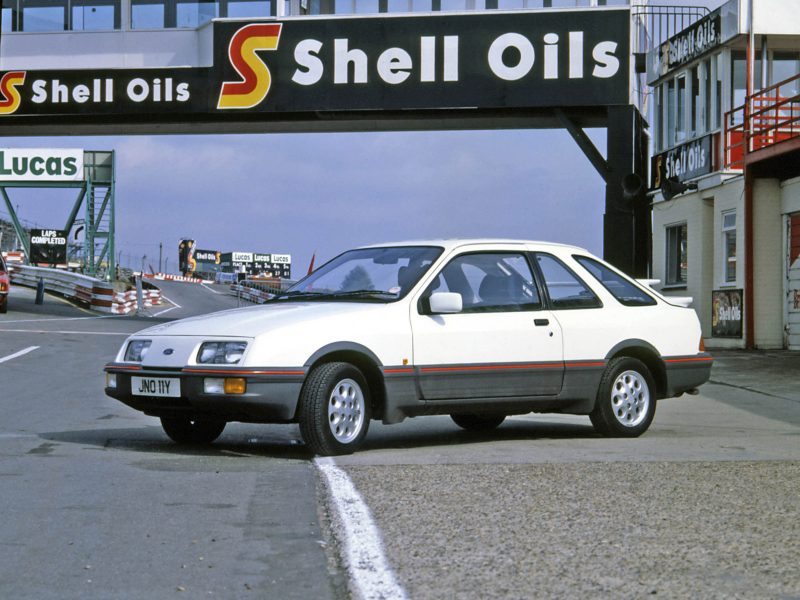The Ford Sierra XR4i was advertised as being able to cruise at two miles a minute. I didn’t swear as much then as I do now but even my fourteen-year-old potty mouth recited it with incredulity: it can cruise at two miles a fucking minute?
Now, of course, almost anything even half interesting can match that, but back-in-the-day a cruising speed of 120mph was hot shit. And that was just the cruising speed remember; Ford didn’t even need to mention the top speed, because it could cruise at two miles a fucking minute.
This stance, the decision to market the speed at which your car can comfortably travel, rather than the one it can reach in the hands of a test driver on a closed road, remains, as far as I can tell, unique. So why is the Ford Sierra XR4i still so fucking cheap? (I’m sorry, but the XR4i is one hell of a fucking car and can only be described accurately using medium-gauge profanity. You don’t believe me? Well, no lesser motoring outlet than the legendary CAR magazine started its review of the then-new XR4i with “JEEEZUSS!” Although, to be fair, I couldn’t find a “fuck” in the whole article, but then CAR at his best wouldn’t have given one anyway.)
Launched in 1983 to a soundtrack of Kajagoogoo and Spandau Ballet, the XR4i was a three-door Sierra with the 2.8-litre ‘Cologne’ V6 from the Capri stuffed under the bonnet, albeit with ‘only’ 150bhp rather than the Capri’s 160bhp in an effort to maintain some brand differentiation. (Something that also explains why the Discovery Sport rides and drives so much worse than the Evoque, with which it shares so much of its chassis.)

Reaction to the then-new high-performance Ford was, well, let’s just say that calling it luke-warm would be to overstate the excitement of the British car buying public, who remained unimpressed with the jellymould’s looks, despite the fitment of a wildly extravagant bi-wing spoiler on the boot lid that reduced rear-end lift by 25% at 90mph. A single spoiler would have done the trick just as well but it would have needed to be so big that it would have stuck out too far beyond the rear bumper. Nor would it have looked as good.
Weedy now, but huge then, 195/50 x 14 tyres filled out the arches so effectively that Ford had to fit side mouldings to help smooth the flow around them. In combination, these stylistic tweaks reduced the car’s co-efficient of drag from 0.34 to 0.32. Heady stuff in the aero-obsessed eighties; remember the Audi 100 boasting of being the most aerodynamic production car in the world with a 0.30Cd?

If Ford could persuade potential buyers to ignore the XR4i’s looks and actually drive the Sierra they were reasonably impressed with the stiffened chassis, Pirelli P6 tyres, and fuel-injected 150bhp engine. (Have I mentioned that the XR4i could cruise at two miles a fucking minute?) Restrained by the standard Recaro bucket seats and gripping the super-chunky steering wheel – with twin horn buttons on it that looked like a “fighter plane’s firing buttons” according to a rather giddy CAR magazine – owners were able to enjoy a car in which 75mph felt like 50, and 120mph (or two miles a fucking minute) was a safe and sensible cruising speed.
The XR4i lasted a scant two years, killed off by consumer apathy and a susceptibility to cross-winds that could catch the unwary out in a heartbeat but it’s hard to imagine that anyone at Ford really cared whether the XR4i lived or died. Originally slated to be a mildly worked over version of both the three- and five-door body-shells fitted with a lack-lustre 2.0-litre four or 2.3-litre V6, only Bob Lutz, Ford’s then head of international operations and renowned petrolhead of the first order, seemed intent on creating a proper high-performance sports car.
The five-door, four-wheel-drive XR4x4 replaced the XR4i in 1985, with the three-door, rear-wheel-drive RS Cosworth coming along in 1986.

For those for whom being able to cruise at two miles a fucking minute wasn’t fast enough, a variety of tuning options were available. Conventional tuning cost a shedload of money for little gains, so most went down the turbo route. The finished product was a direct reflection of the depth of your pockets, but the ultimate was a 230bhp Turbo Technics conversion that slashed one-and-a-half seconds off the 0-60mph time and added 10mph to the top speed. Crucially though, it knocked a whopping five-and-a-half seconds off the 0-100mph time, which turned it into a seriously fast car.
Others preferred to deal with a chassis that still felt like the balance between handling and comfort was more family oriented that it should have been; Motorsport magazine saying: “The crucial difference between the Sierra and the Capri is in the suspension department, the saloon being more softly sprung and definitely biased towards comfort rather than outright handling. Where the Capri is “chuckable” the Sierra needs more finesse, the independent rear trailing link system and softer progressive springs allowing a fair amount of roll and tuck when exploring the limits despite the addition of a 10mm anti-roll bar.”
So decent bushes, adjustable dampers, and a free-flowing exhaust were thought by many to be a cost-effective option than the complication of fitting a turbocharger. After all, it could already cruise at two miles a fucking minute, so only needed the handling tuned to balance the power that was on offer. Either way, oversteer was a constant threat, even if the reality was a little less lairy than the experts down the pub – the 1980’s equivalent of today’s internet warriors – would have you believe.

Of course, driven now, the standard XR4i is mildly underwhelming. The suspension is a bit soft, the grip from those reasonably skinny tyres isn’t terribly strong, and the V6 engine’s 150bhp and 156lb ft of torque feels mildly muscular rather than wickedly fast, even if the 1,205kgs kerb weight makes for a decent power-to-weight ratio. Sixty comes up in around seven-and-a-half seconds and the mid-range torque makes overtaking effortless, if there’s enough space…
But then you remember that you are driving a car that can cruise at two miles a fucking minute. It’s a bona fida legend that can genuinely be spoken of in the same breath as a Lotus Carlton or an Audi Quattro. It’s a bare-knuckle bruiser squeezed into a suit that was hastily bought for a sister-in-law’s second wedding, as Lee Child might have put it. That you are judging it by today’s standards and finding it wanting is absurd. You are driving a piece of history, a piece of nostalgia, and when you remember that it can cruise at two miles a fucking minute you don’t give a fuck that a 208GTi would eat it for breakfast, burp and then shag its little sister, the RS Turbo before wiping its, well, shall we just say that the Peugeot is an uncouth little bugger and leave it at that?
At the end of 2015 there were just 12 on the road, with another 37 on SORN, making them rare, as well as desirable. As a consequence, the XR4i is just starting to move into the realm where it is worth spending money on them, rather than having the scrap man come and carry them off when they’ve succumbed to MOT-failure levels of rot. Which they are prone to do.

If you’re looking to restore one, then the mechanical bits are, as is so often the case, relatively easy to come by and it’s the bits of trim that will stymie the enthusiast who is looking to get them back into showroom condition which is, surely, the only thing to do with something that can cruise at two miles a fucking minute?
Good, original, one-owner-from-new examples go for well under ten grand, which is ridiculously cheap for such an iconic car, a derivative of which – the Cosworth – goes for five times that (and rising fast). Fast Fords are on the up and few people are paying the Sierra XR4i any attention at the moment, something I can’t see staying the case for long.
So, the XR4i was a bit of a sleeper in the 1980s, and it remains one even today; if you’ve got the cash and the garage space then this is definitely one invest in and while ISAs are still giving 1%, Dagenham’s finest represents the best possible chance of giving you a double-digit annual return[1].
Buy a good ‘un (you know what that means by now, don’t you? Provenance and rust, provenance and rust), and if it doesn’t make you very happy indeed in five years then I’m hanging up my pen and going to live in the woods with a chainsaw and a moonshine still.
Carlton Boyce
[1] Please remember: I am a motoring journalist, not an investment advisor, so my advice is worth exactly what you paid for it.